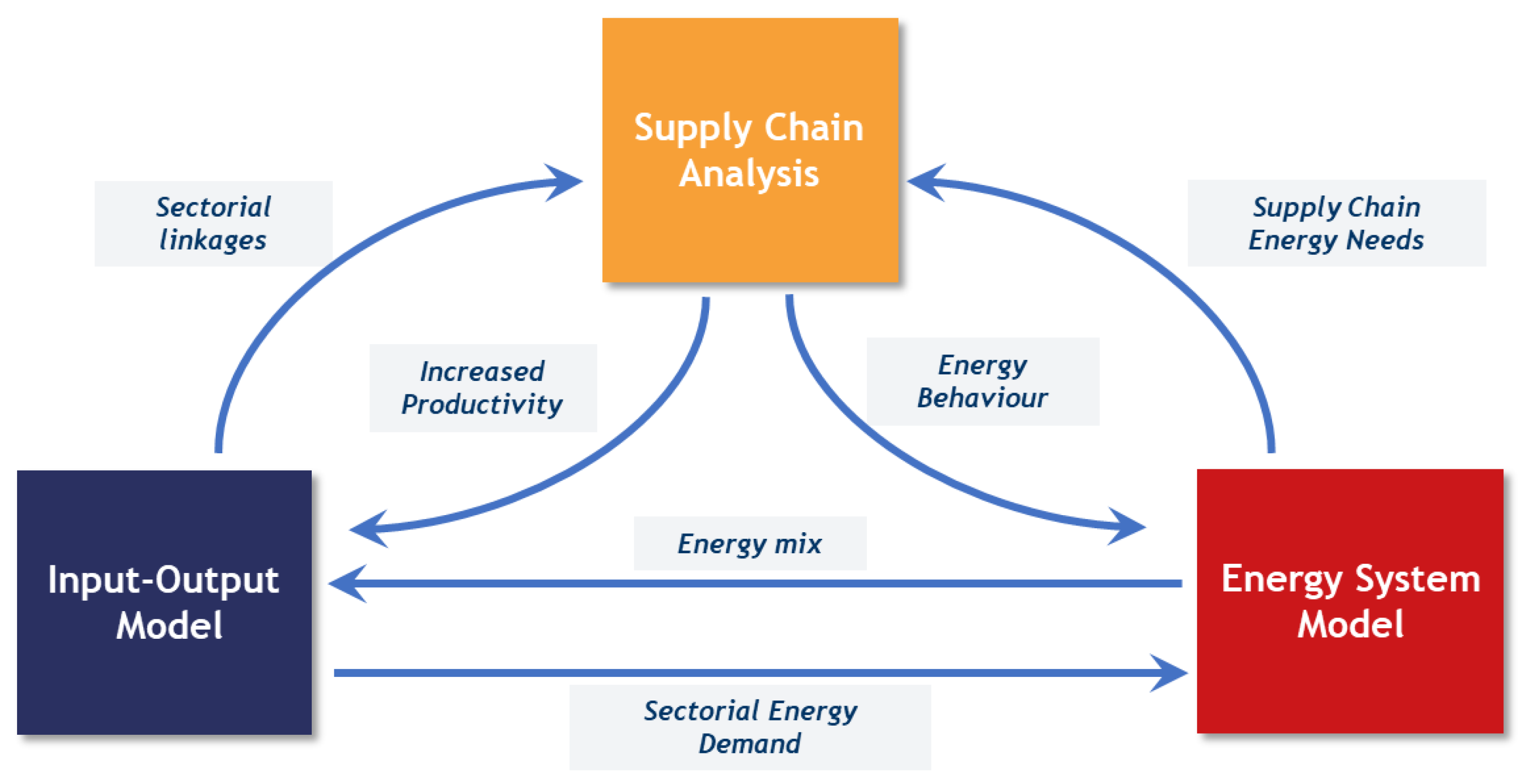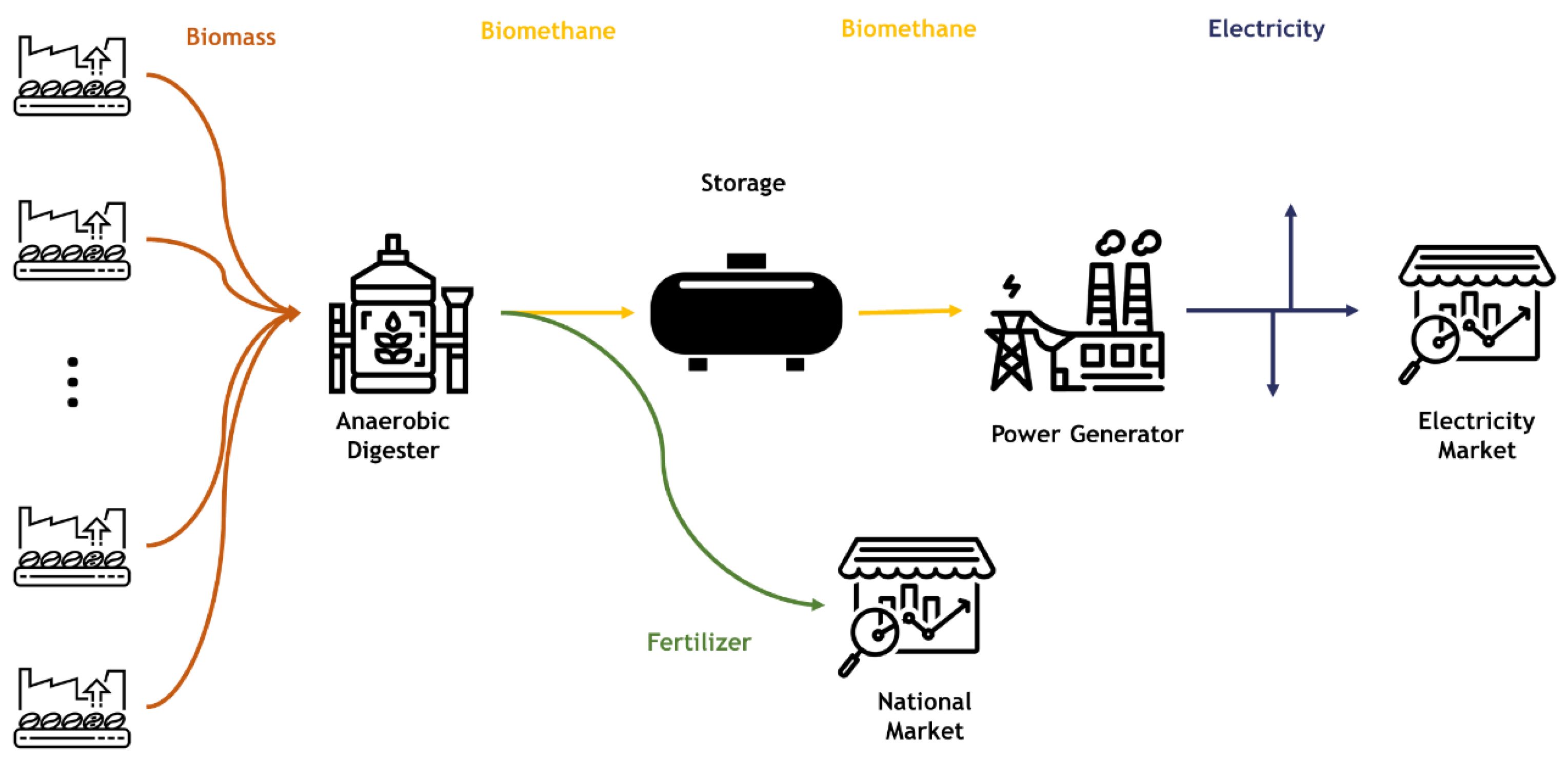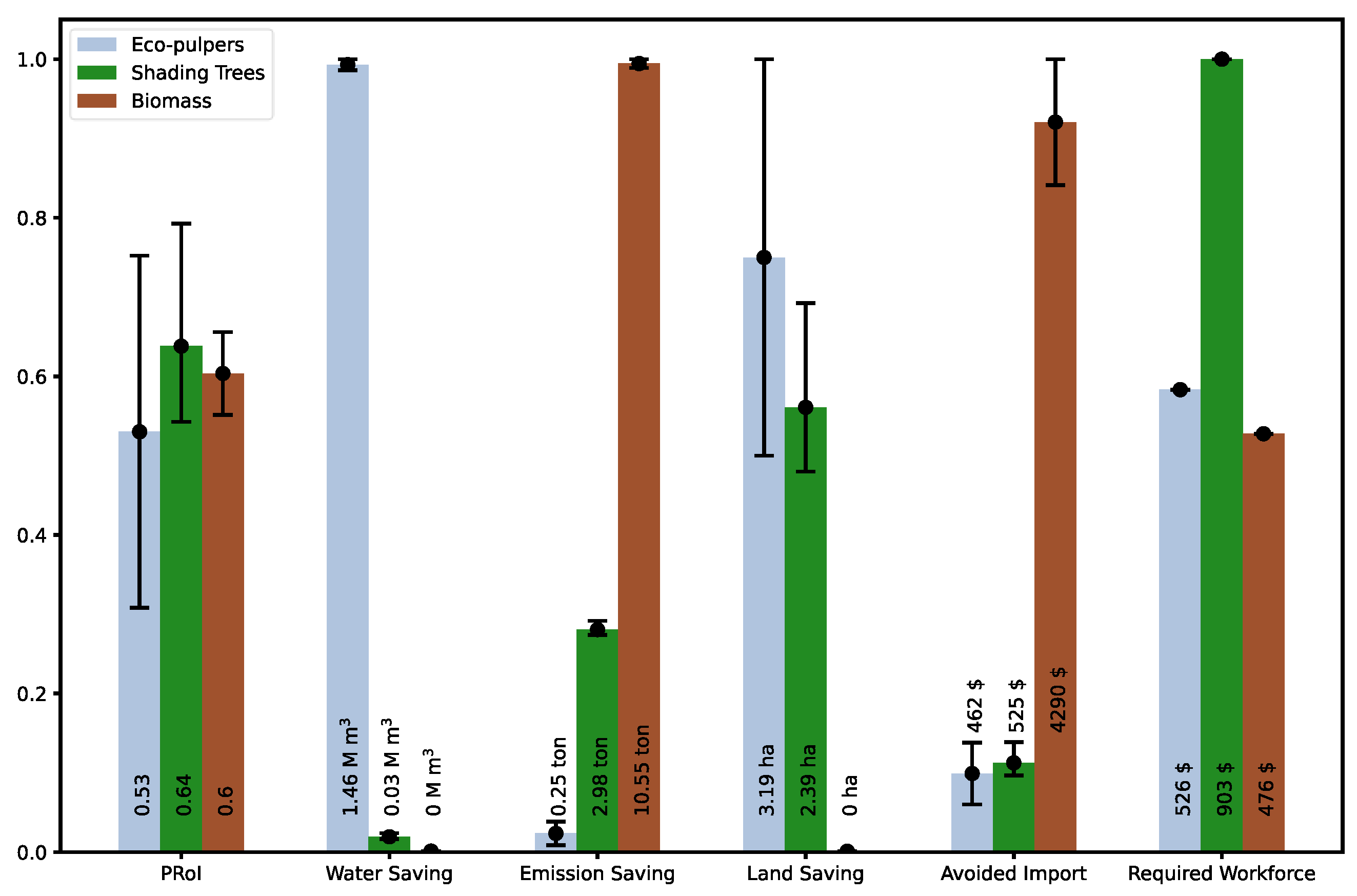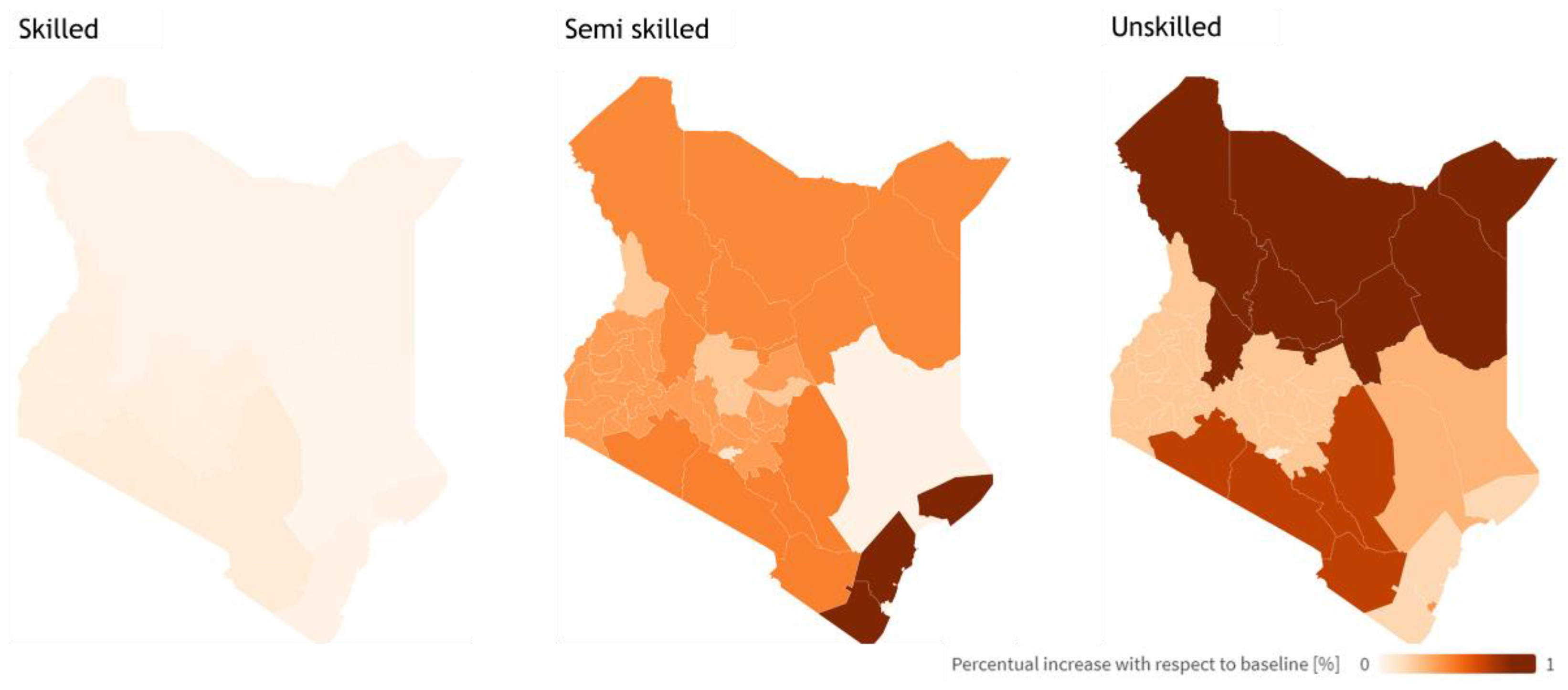Comprehensive and Integrated Impact Assessment Framework for Development Policies Evaluation: Definition and Application to Kenyan Coffee Sector
Abstract
:1. Introduction
2. Materials and Methods
2.1. Interaction among the Tools within CIVICS Framework
- Investment assessment: in this step, it is required to characterize all the commodities needed to have the technology produced and installed (e.g., the cost of machinery and the required training course). From a modeling point of view, this will be translated by simply adding the required commodities to the final demand vector. The investment will be handled, as shown in (1), with the current technology assessment (no subscript identifies baseline data, while subscript i identifies investment data);
- Operation assessment: in this step, it is required to describe all the cross-sectoral changes that are occurring due to the installed technology. The structural change in operation will influence, as shown in (2), how the baseline final demand is delivered (subscript o identifies data after the implementation of the intervention). These changes may be translated to the model in the following ways:
- Change in the use coefficients matrix (u, the use side of matrix z): a specific variation of u can reflect a change in how much input of a certain commodity is required for one unit of output (e.g., machinery, not used in the baseline, will directly increase the consumption of diesel in a certain activity).
- Change in the satellite account coefficients matrices (f and e): a specific variation of f or e can reflect a change in activity intensities (e.g., machinery, not used in the baseline, will directly emit an additional amount of CO2 emissions in performing a certain activity).
- Change in the market share matrix (v, the make side of matrix z): a specific variation of a v coefficient represents how much of each activity is required every time a certain commodity is demanded. Therefore, a change in the v matrix could be used to model the change in the productivity of a specific activity. In fact, productivity is how much output is produced for each unit of input, or, in the case of a demand-driven model, how much input is needed to deliver the same output (e.g., the physical productivity of coffee plants increases because of the introduced technology).
2.2. Evaluating and Comparing Interventions within the CIVICS Framework
3. Case Study
3.1. Agriculture in Kenya: Addressing the Supply Chain Analysis of the Coffee Sector
- The introduction of shading management practices via trees, through intercropping in coffee plantations (shading trees);
- The introduction of innovative water-saving pulping machinery for the wet milling process (eco-pulpers);
- The exploitation of coffee wet-processing waste as a source of biomass for energy and fertilizer production (biomass).
3.2. Applying CIVICS Methodology to the Coffee Sector in Kenya
- Shading management via trees
- Increased resilience to climate change and extreme weather events;
- Increased incomes and improved food and nutrition security;
- Improved plant growth and enhanced coffee quality;
- Reduction in greenhouse gas emissions.
- Negative impact on physical yield;
- High level of initial investment.
| Description | Value | Unit of Measure | Reference |
|---|---|---|---|
| Number of coffee plants | 1800–2200 1 | Plants/hectare | [28] |
| Fraction of shading trees to coffee plants | 25 | % | [37] |
| Cost of purchasing a shading banana plant | 1.3 | $/plant | [38] |
| Cost of planting a shading banana plant | 0.13 | $/plant | Estimation: a 10% cost over purchasing was assumed. |
| Banana yield | 15 | kg/plant | [39] |
| Banana price | 0.065 | $/kg | [39] |
| Reduction in physical yield (optimum level of shading) | 8–15 | % | [37] |
| Reduction in monetary yield (potential price growth) | 2 | % | [36] |
| Increase in the total soil carbon stocks | 3.8 | ton/ha | [36] |
| Reduction in required capital-machines | 27 | % | [40] |
| Growth in demand for labor | 38 | % | [40] |
| Useful life of the shading plants | 20 | years | Estimation: multiple banana trees emerging from the same rhizome in a couple of decades |
- b
- Eco-pulper for wet milling process
- c
- Exploiting biomass from coffee organic waste
| Description | Value | Unit of Measure | Reference |
|---|---|---|---|
| Specific cost of biodigester | 10,000 | $/Nm3/h | Estimation: assumed on the basis of field interviews and industrial players’ judgments. |
| Specific cost of storage | 0 | $/Nm3 | Estimation: assumed on the basis of field interviews and industrial players’ judgments. |
| Specific cost of generator | 500 | $/kW | Estimation: assumed on the basis of field interviews and industrial players’ judgments. |
| Electricity production in one year by new plants | 80 | GWh | Energy modeling output (Calliope) 1 |
| Carbon intensity of electricity production from heavy fuel oil | 0.27 | kgCO2/kWh | [43] |
| Efficiency of the old diesel generators to be replaced | 0.4 | - | Estimation: average efficiency of diesel generators. |
| Biomass to fertilizer rate | 0.3 | - | Estimation: assumed on the basis of field interviews and expert judgments. |
| Labor cost 2 | 37.5 | [51] | |
| Size of biodigester | 250 | Nm3/h | Estimation: assumed on the basis of biomass plant characteristics. |
| Size of generator | 25,000 | Nm3 | Estimation: assumed on the basis of biomass plant characteristics. |
| Size of storage | 1 | MW | Estimation: assumed on the basis of biomass plant characteristics. |
| Increase in use of transport commodity by cooperatives | 30% | - | Estimation: assumed based on coffee fields and biomass plant proximity. |
| Useful life of the machines | 25 | years | Estimation: assumed on the basis of biomass plant characteristics. |
4. Results and Discussion
- Integrated Multidimensional Analysis: evaluate the impact of different interventions and create a set of comparable and case-specific indices. In the present case, the focus is on six indicators, which are connected to as many SDGs.
- Policy Goal: find an optimized mix of strategies that is compliant with policy-makers’ main concerns while respecting other policy objectives. For this specific case study, a budget constraint of $100m is set. In this case, the maximization of the savings of economic production factors is first compared in the absence of further constraints and then subjected to one on green-water savings and reduction in CO2 emissions.
- Required workforce: It represents the amount of additional labor, by means of required wages expenditure for $9k of investment. In this study, it can be noticed that introducing shading trees leads to the most dominant positive increase in local labor impact. In fact, the sectors associated with the harvesting and maintenance of banana trees are characterized by more labor intensiveness compared to the other interventions. This could have desirable effects in getting close to the objective depicted by SDG 8, introducing positive conditions to enable economic growth and decent jobs.
- Avoided import: Although being resilient to external shocks can play a role in improving the economic conditions of a country, it is not easy to put into practice when the considered economy is largely dependent on the import of crucial commodities (e.g., petroleum). The biomass intervention in this research permits one to decrease this dependence by the local production of a non-negligible share of imported products. Furthermore, extracting value from coffee waste, which was formerly an unexploited resource, is aligned with SDG 12, ensuring a sustainable production and consumption pattern.
- Land saving: This indicator is associated with SDG 6, which promotes the sustainable use of terrestrial ecosystems and avoids land degradation. Land-use reduction by installing eco-pulpers is highly dependent on the assumed new productivity, influencing, importantly, the number of new inputs saved per unit of production. On the one hand, eco-pulpers allow for a more resource-efficient conversion of coffee berries into green coffee, reducing waste per unit of output. On the other hand, intercropping makes land use more efficient by exploiting banana–coffee synergies.
- Emission saving: Carbon emissions are considerably reduced by adopting biomass intervention due to the shift in electricity mix from heavy fuel oil to biomass combustion, which follows the climate action proposed by SDG 13. In fact, the activity of the highly carbon-intense heavy fuel oil is limited by substituting part of the fixed overall electricity production by means of the new—according to modeling assumptions, carbon-neutral—power production technology.
- Water-saving: This impact is extremely relevant when wet mills are substituted by eco-pulpers, allowing for the sustainable management of water introduced by SDG 6. Eco-pulpers are increasing the overall efficiency of the process (which is also true for the shading trees intervention) and heavily reducing the amount of water required per unit of processed coffee.
- PROI: Considering shading management intervention, the main economic benefit is associated with the introduction of additional revenue-generation activity, which is the production of bananas coming out of the shading trees. This benefit compensates for the reduction in coffee productivity in cooperatives, leading to a higher Policy Return on Investment compared to the other strategies. On the other hand, the annual return on investment in eco-pulper intervention is mostly due to the savings coming from the direct impact of the increase in the productivity in cooperatives on the economic factors of this sector. Although the adoption of biomass resources does not increase the physical productivity of coffee, the reduction in imports of petroleum and fertilizers due to the intervention leads to an annual saving of around $20m.
5. Conclusions
Supplementary Materials
Author Contributions
Funding
Institutional Review Board Statement
Informed Consent Statement
Data Availability Statement
Acknowledgments
Conflicts of Interest
References
- UN. Transforming Our World: The 2030 Agenda for Sustainable Development; United Nations: New York, NY, USA, 2015. [Google Scholar]
- Nwanze, K.F. Smallholders Can Feed the World; IFAD: Rome, Italy, 2017. [Google Scholar]
- Ritchie, H.; Roser, M. Environmental Impacts of Food Production. Available online: https://ourworldindata.org/environmental-impacts-of-food (accessed on 1 April 2022).
- Welsch, M.; Hermann, S.; Howells, M.; Rogner, H.H.; Young, C.; Ramma, I.; Bazilian, M.; Fischer, G.; Alfstad, T.; Gielen, D.; et al. Adding Value with CLEWS—Modelling the Energy System and Its Interdependencies for Mauritius. Appl. Energy 2014, 113, 1434–1445. [Google Scholar] [CrossRef]
- Sridharan, V.; Ramos, E.P.; Zepeda, E.; Boehlert, B.; Shivakumar, A.; Taliotis, C.; Howells, M. The Impact of Climate Change on Crop Production in Uganda-An Integrated Systems Assessment with Water and Energy Implications. Water 2019, 11, 1805. [Google Scholar] [CrossRef] [Green Version]
- Bazilian, M.; Rogner, H.; Howells, M.; Hermann, S.; Arent, D.; Gielen, D.; Steduto, P.; Mueller, A.; Komor, P.; Tol, R.S.J.; et al. Considering the Energy, Water and Food Nexus: Towards an Integrated Modelling Approach. Energy Policy 2011, 39, 7896–7906. [Google Scholar] [CrossRef]
- Sridharan, V.; Broad, O.; Shivakumar, A.; Howells, M.; Boehlert, B.; Groves, D.G.; Rogner, H.H.; Taliotis, C.; Neumann, J.E.; Strzepek, K.M.; et al. Resilience of the Eastern African Electricity Sector to Climate Driven Changes in Hydropower Generation. Nat. Commun. 2019, 10, 1–9. [Google Scholar] [CrossRef] [Green Version]
- Wang, C.; Malik, A.; Wang, Y.; Chang, Y.; Lenzen, M.; Zhou, D.; Pang, M.; Huang, Q. The Social, Economic, and Environmental Implications of Biomass Ethanol Production in China: A Multi-Regional Input-Output-Based Hybrid LCA Model. J. Clean. Prod. 2020, 249, 119326. [Google Scholar] [CrossRef]
- Palma-Rojas, S.; Caldeira-Pires, A.; Nogueira, J.M. Environmental and Economic Hybrid Life Cycle Assessment of Bagasse-Derived Ethanol Produced in Brazil. Int. J. Life Cycle Assess. 2017, 22, 317–327. [Google Scholar] [CrossRef]
- Tanimonure, V.A.; Naziri, D. Impact of Climate Adaptation Strategies on the Net Farm Revenue of Underutilised Indigenous Vegetables’ (UIVs) Production in Southwest Nigeria. Resour. Environ. Sustain. 2021, 5, 100029. [Google Scholar] [CrossRef]
- Mungai, E.M.; Ndiritu, S.W.; Da Silva, I. Unlocking Climate Finance Potential and Policy Barriers—A Case of Renewable Energy and Energy Efficiency in Sub-Saharan Africa. Resour. Environ. Sustain. 2022, 7, 100043. [Google Scholar] [CrossRef]
- Mainar-Causapé, A.J.; Boulanger, P.; Dudu, H.; Ferrari, E. Policy Impact Assessment in Developing Countries Using Social Accounting Matrices: The Kenya SAM 2014. Rev. Dev. Econ. 2020, 24, 1128–1149. [Google Scholar] [CrossRef]
- Adil Suliman Hussain, L.; Inzoli, F.; Golinucci, N.; Stevanato, N.; Rocco, M.V.; Colombo, E. Supply Chain Analysis with Focus on Africa FEEM’s Methodological Approach; Milan, Italy, 2020. Available online: https://papers.ssrn.com/sol3/papers.cfm?abstract_id=3733685 (accessed on 1 April 2022).
- Galal, N.M.; Moneim, A.F.A. Developing Sustainable Supply Chains in Developing Countries. Procedia CIRP 2016, 48, 419–424. [Google Scholar] [CrossRef] [Green Version]
- Suh, S. Handbook of Input-Output Economics in Industrial Ecology; Springer: Berlin/Heidelberg, Germany, 2009; ISBN 9781402040832. Available online: https://link.springer.com/book/10.1007/978-1-4020-5737-3 (accessed on 1 April 2022).
- Miller, R.E.; Blair, P.D. Input-Output Analysis: Foundations and Extensions; Cambridge University Press: Cambridge, UK, 2009; ISBN 1139477595. [Google Scholar]
- Lenzen, M.; Rueda-Cantuche, J.M. A Note on the Use of Supply-Use Tables in Impact Analyses. Sort 2012, 36, 139–152. [Google Scholar]
- Södersten, C.J.H.; Lenzen, M. A Supply-Use Approach to Capital Endogenization in Input–Output Analysis. Econ. Syst. Res. 2020, 32, 451–475. [Google Scholar] [CrossRef]
- Tahavori, M.A.; Rinaldi, L.; Golinucci, N. SESAM-Polimi/MARIO: MARIO v0.1.0. 2022. Available online: https://zenodo.org/record/5879383#.YmIAptNBxPY (accessed on 1 April 2022).
- Pfenninger, S.; Pickering, B. Calliope: A Multi-Scale Energy Systems Modelling Framework. J. Open Source Softw. 2018, 3, 825. [Google Scholar] [CrossRef] [Green Version]
- Pfenninger, S.; Keirstead, J. Renewables, Nuclear, or Fossil Fuels? Scenarios for Great Britain’s Power System Considering Costs, Emissions and Energy Security. Appl. Energy 2015, 152, 83–93. [Google Scholar] [CrossRef] [Green Version]
- Shenoy, M. Industrial Ecology in Developing Countries; Springer: Cham, Switzerland, 2015; ISBN 9783319205717. [Google Scholar]
- Arzoumanidis, I.; D’Eusanio, M.; Raggi, A.; Petti, L. Functional Unit Definition Criteria in Life Cycle Assessment and Social Life Cycle Assessment: A Discussion. In Perspectives on Social LCA: Contributions from the 6th International Conference; Traverso, M., Petti, L., Zamagni, A., Eds.; Springer International Publishing: Cham, Switzerland, 2020; pp. 1–10. ISBN 978-3-030-01508-4. [Google Scholar]
- Boulanger, P.; Dudu, H.; Ferrari, E.; Causapé, A.J.M.; Balié, J.; Battaglia, L. Policy Options to Support the Agriculture Sector Growth and Transformation Strategy in Kenya; Joint Research Centre: Petten, The Netherlands, 2018; ISBN 9789279859496. [Google Scholar]
- Government of the Republic of Kenya. The Kenya Vision 2030, The Popular Version. 2007. Available online: https://vision2030.go.ke/publication/kenya-vision-2030-popular-version/ (accessed on 1 April 2022).
- Kenya Institute for Public Policy Research and Analysis. Kenya Economic Report 2019: Resource Mobilization for Sustainable. 2019. Available online: https://repository.kippra.or.ke/handle/123456789/2098 (accessed on 1 April 2022).
- World Bank Group. Kenya Economic Update: Unbundling the Slack in Private Sector Investment—Transforming Agriculture Sector Productivity and Linkages to Poverty Reduction. 2019, pp. 1–86. Available online: https://openknowledge.worldbank.org/handle/10986/31515 (accessed on 1 April 2022).
- International Coffee Organization. Country Coffee Profile Kenya. 2019. Available online: https://www.ico.org/documents/cy2018-19/icc-124-7e-profile-kenya.pdf (accessed on 1 April 2022).
- Thuku, G.K.; Gachanja, P.; Almadi, O. Effects of Reforms on Productivity of Coffee in Kenya. Int. J. Bus. Soc. Sci. 2013, 4, 196–213. [Google Scholar]
- Damianopoulos, R.A. Market Adaptability, Industrial Divergence, and the Politics of Liberalization in the Kenyan and Ugandan Coffee Industries; Queen’s University: Kingston, ON, Canada, 2005. [Google Scholar]
- Kenya Coffee Platform. Coffee Economic Viability Study. 2018. Available online: https://www.globalcoffeeplatform.org/wp-content/uploads/2021/03/Kenya-Coffee-Platform-Coffee-Economic-Viability-Study-Report-F.pdf (accessed on 1 April 2022).
- UNCTAD Commodoities at a Glance, Special Issue on Coffee in East Africa. United Nations Conference on Trade and Development. 2018. Available online: https://unctad.org/system/files/official-document/ditccom2018d1_en.pdf (accessed on 1 April 2022).
- Causapé, A.J.M.; Boulanger, P.; Dudu, H.; Ferrari, E.; Mcdonald, S. Social Accounting Matrix of Kenya. 2014. Available online: http://data.europa.eu/89h/bc924665-e888-4642-9b3b-297f4f6b13d3 (accessed on 1 April 2022).
- Lenzen, M.; Moran, D.; Kanemoto, K.; Geschke, A. Building Eora: A Global Multi-Region Input-Output Database at High Country and Sector Resolution. Econ. Syst. Res. 2013, 25, 20–49. [Google Scholar] [CrossRef]
- FAO. Agroforestry Coffee Cultivation in Combination with Mulching, Trenches and Organic Composting in Uganda. 2017. Available online: https://www.fao.org/3/ca3728en/ca3728en.pdf (accessed on 1 April 2022).
- van Asten, P.; Ochola, D.; Wairegi, L.; Nibasumba, A.; Jassogne, L.; Mukasa, D. Coffee-Banana Intercropping Implementation Guidance for Policymakers and Investors; FAO: Rome, Italy, 2015; p. 10. [Google Scholar]
- Rahn, E.; Vaast, P.; Läderach, P.; van Asten, P.; Jassogne, L.; Ghazoul, J. Exploring Adaptation Strategies of Coffee Production to Climate Change Using a Process-Based Model. Ecol. Model. 2018, 371, 76–89. [Google Scholar] [CrossRef]
- Shading Plant Cost. Available online: https://perfectdailygrind.com/2015/06/how-much-does-it-cost-a-farmer-to-plant-a-basic-plot/ (accessed on 1 April 2022).
- Wairegi, L.; Van Asten, P.; Giller, K.; Fairhurst, T. Banana-Coffee System Cropping Guide; CAB International: Wallingford, UK, 2014; ISBN 9781780644929. [Google Scholar]
- Jezeer, R.E.; Santos, M.J.; Boot, R.G.A.; Junginger, M.; Verweij, P.A. Effects of Shade and Input Management on Economic Performance of Small-Scale Peruvian Coffee Systems. Agric. Syst. 2018, 162, 179–190. [Google Scholar] [CrossRef]
- CAL—Coffee Machinery—Mini Eco Pulper. Available online: https://www.cal-ea.com/ (accessed on 1 April 2022).
- Alibaba.com Eco Mini Pulper Cost. Available online: https://www.alibaba.com/product-detail/Mini-Eco-Pulper-for-coffee_135021838.html (accessed on 23 September 2020).
- Combustion of Fuels—Carbon Dioxide Emission. Available online: https://www.engineeringtoolbox.com/co2-emission-fuels-d_1085.html (accessed on 1 April 2022).
- Murthy, P.S.; Madhava Naidu, M. Sustainable Management of Coffee Industry By-Products and Value Addition—A Review. Resour. Conserv. Recycl. 2012, 66, 45–58. [Google Scholar] [CrossRef]
- Ulsido, M.D.; Li, M. Solid Waste Management Practices in Wet Coffee Processing Industries of Gidabo Watershed, Ethiopia. Waste Manag. Res. 2016, 34, 638–645. [Google Scholar] [CrossRef]
- Mwangi, R.W.; Mwenda, L.K.M.; Wachira, A.W.; Mburu, D.K. Effect of Final Processing Practices Carried out by the Coffee Cooperative Societies on the Sustainability of the Coffee Industry in Kenya. Eur. J. Bus. Strateg. Manag. 2017, 2, 60–75. [Google Scholar]
- Surendra, K.C.; Takara, D.; Hashimoto, A.G.; Khanal, S.K. Biogas as a Sustainable Energy Source for Developing Countries: Opportunities and Challenges. Renew. Sustain. Energy Rev. 2014, 31, 846–859. [Google Scholar] [CrossRef]
- Sogn, T.A.; Dragicevic, I.; Linjordet, R.; Krogstad, T.; Eijsink, V.G.H.; Eich-Greatorex, S. Recycling of Biogas Digestates in Plant Production: NPK Fertilizer Value and Risk of Leaching. Int. J. Recycl. Org. Waste Agric. 2018, 7, 49–58. [Google Scholar] [CrossRef] [Green Version]
- Battista, F.; Frison, N.; Bolzonella, D. Energy and Nutrients’ Recovery in Anaerobic Digestion of Agricultural Biomass: An Italian Perspective for Future Applications. Energies 2019, 12, 3287. [Google Scholar] [CrossRef] [Green Version]
- Balié, J.; Battaglia, L.; Boulanger, P.; Dudu, H.; Ferrari, E.; Mainar Causapé, A.J. Returns to Investments in Fertilizers Production in Kenya. In An Analysis in Support of the New “Agriculture Sector Growth and Transformation Strategy”; Food and Agriculture Organization of the United Nations (FAO) and Joint Research C: Rome, Italy, 2019. [Google Scholar]
- Salaries by Positions—Kenya.Paylab.Com. Available online: https://kenya.paylab.com/ (accessed on 1 April 2022).
- Gathuo, B.; Rantala, P.; Maatta, R. Coffee Industry Wastes. Water Sci. Technol. 1991, 24, 53–60. [Google Scholar] [CrossRef]
- Chi, G.; Fang, H.; Chatterjee, S.; Blumenstock, J.E. Microestimates of Wealth for All Low- and Middle-Income Countries. Proc. Natl. Acad. Sci. USA 2022, 119, e2113658119. [Google Scholar] [CrossRef]
- Pfenninger, S.; DeCarolis, J.; Hirth, L.; Quoilin, S.; Staffell, I. The Importance of Open Data and Software: Is Energy Research Lagging Behind? Energy Policy 2017, 101, 211–215. [Google Scholar] [CrossRef]






| Description | Value | Unit of Measure | References |
|---|---|---|---|
| Cost of eco-pulping machine | 1430 | $ | [41,42] |
| Cost of delivery | 46 | $ | Estimation: a 10% cost over purchasing was assumed. |
| Required power | 1.1 | kW | [41,42] |
| Capacity of the machine | 0.5 | tons of coffee/h | [41,42] |
| Efficiency of the machine | 30 | % | [41,42] |
| Decrease in water footprint | 85 | % | [41,42] |
| Number of smallholders to be covered by each machine | 300–600 | Smallholder/machine | Estimation: based on coffee fields productivity, proximity, and machinery capacity. |
| Productivity increase | 0–2.5 | % | Estimation: assumed on the basis of field interviews and expert judgments. |
| Carbon intensity of the eco-pulpers electricity consumption | 0.27 | kgCO2/kWh | [43] |
| Useful life of the eco-pulpers | 10 | years | Estimation: based on similar machinery’s expected life. |
| Without Env. Objectives | With Env. Objectives | |
|---|---|---|
| Eco-pulpers | 0%, 0% | 1%, 34% |
| Shading Trees | 63%, 100% | 50%, 79% |
| Biomass | 37%, 73% | 49%, 98% |
Publisher’s Note: MDPI stays neutral with regard to jurisdictional claims in published maps and institutional affiliations. |
© 2022 by the authors. Licensee MDPI, Basel, Switzerland. This article is an open access article distributed under the terms and conditions of the Creative Commons Attribution (CC BY) license (https://creativecommons.org/licenses/by/4.0/).
Share and Cite
Golinucci, N.; Stevanato, N.; Namazifard, N.; Tahavori, M.A.; Sulliman Hussain, L.A.; Camilli, B.; Inzoli, F.; Rocco, M.V.; Colombo, E. Comprehensive and Integrated Impact Assessment Framework for Development Policies Evaluation: Definition and Application to Kenyan Coffee Sector. Energies 2022, 15, 3071. https://doi.org/10.3390/en15093071
Golinucci N, Stevanato N, Namazifard N, Tahavori MA, Sulliman Hussain LA, Camilli B, Inzoli F, Rocco MV, Colombo E. Comprehensive and Integrated Impact Assessment Framework for Development Policies Evaluation: Definition and Application to Kenyan Coffee Sector. Energies. 2022; 15(9):3071. https://doi.org/10.3390/en15093071
Chicago/Turabian StyleGolinucci, Nicolò, Nicolò Stevanato, Negar Namazifard, Mohammad Amin Tahavori, Lamya Adil Sulliman Hussain, Benedetta Camilli, Federica Inzoli, Matteo Vincenzo Rocco, and Emanuela Colombo. 2022. "Comprehensive and Integrated Impact Assessment Framework for Development Policies Evaluation: Definition and Application to Kenyan Coffee Sector" Energies 15, no. 9: 3071. https://doi.org/10.3390/en15093071
APA StyleGolinucci, N., Stevanato, N., Namazifard, N., Tahavori, M. A., Sulliman Hussain, L. A., Camilli, B., Inzoli, F., Rocco, M. V., & Colombo, E. (2022). Comprehensive and Integrated Impact Assessment Framework for Development Policies Evaluation: Definition and Application to Kenyan Coffee Sector. Energies, 15(9), 3071. https://doi.org/10.3390/en15093071








